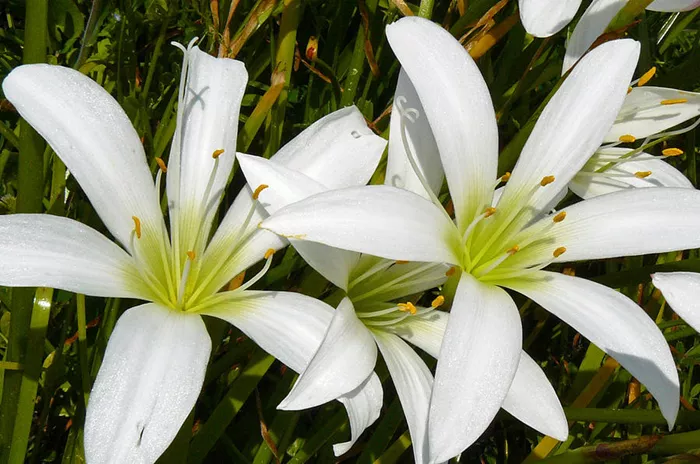Easter lilies, known for their stunning white blooms, symbolize purity, innocence, and virtue. These beautiful flowers are often associated with the resurrection of Jesus Christ during the Easter season, making them a powerful symbol of spiritual renewal. Their pristine white petals represent the purity of Christ, offering a connection between nature and the divine.
A Historical Symbol in Christianity
The use of Easter lilies in Christian tradition dates back to the early 20th century, but their symbolism goes much further. Historically, lilies were seen as symbols of divine perfection and sacred grace. As Christianity spread, these flowers became a prominent part of Easter celebrations, honoring the resurrection of Jesus. The Easter lily was especially adopted during the 19th century when the flower’s connection to Easter became more pronounced in religious art and symbolism.
Easter Lilies in Garden Design and Decoration
Perfect for Spring Gardens
Aside from their spiritual symbolism, Easter lilies are a delightful addition to any spring garden. Their large, trumpet-shaped blooms appear at the height of spring, offering a burst of white amidst the fresh greenery. Planting Easter lilies in your garden can add a touch of elegance and sophistication, particularly when combined with other spring flowers like tulips and daffodils.
Floral Arrangements for Easter Celebrations
Easter lilies are commonly used in floral arrangements, particularly during Easter services and festive gatherings. Their pristine white petals make them the perfect complement to other seasonal flowers, such as roses, tulips, and daffodils. These arrangements are often used to adorn churches, homes, and Easter tables, creating a serene atmosphere filled with beauty and grace.
Symbol of Hope and Rebirth in Your Garden
When planted in the garden, Easter lilies are a symbol of hope and rebirth. Their annual blooms during the Easter season remind gardeners of the cyclical nature of life and growth. These lilies bring a sense of rejuvenation to any garden, offering a reminder that with each passing season, new life emerges, bringing fresh starts and possibilities.
The Care and Growth of Easter Lilies
Planting Easter Lilies
For optimal growth, Easter lilies prefer well-drained soil and a sunny location. Plant them in the fall, about 6 inches deep, ensuring that they receive enough sunlight but are shielded from harsh afternoon rays. The bulbs should be spaced about 8-12 inches apart to allow room for the plants to grow and bloom fully.
Watering and Fertilization
Easter lilies thrive with moderate watering. They do not tolerate soggy soil, so ensure that the soil drains well. A balanced, slow-release fertilizer applied during the growing season will help promote strong growth and vibrant blooms. Avoid overwatering, as this can lead to bulb rot and other issues.
After-Bloom Care and Replanting
Once the flowers have finished blooming, the plants may begin to die back. However, the bulbs can be saved for next year. Cut back the spent flowers and leaves, but leave the bulbs in the soil. In some climates, Easter lilies can be left to overwinter outdoors. In colder regions, it may be best to dig up the bulbs and store them in a cool, dry place until the next planting season.
Meaning of Easter Lilies in Different Cultures
Symbol of Purity and Life Across Cultures
While Easter lilies are most commonly associated with Christianity, they also hold significance in various other cultures. In Greek mythology, lilies were connected to the goddess Hera, representing motherhood and nurturing. In Christianity, their white petals symbolize purity and the hope of eternal life. Across many traditions, lilies are seen as symbols of renewal, fertility, and love.
Celebrating Easter Around the World
In many parts of the world, Easter lilies are a central part of Easter celebrations. For example, in Mexico, the lily is considered a symbol of Christ’s resurrection. The flower is often incorporated into religious celebrations, from processions to church altars. Similarly, in Europe and the United States, Easter lilies are commonly featured in church decorations and as part of Easter baskets, symbolizing new beginnings and the triumph of life over death.
How to Incorporate Easter Lilies into Your Home Décor
As Table Centerpieces
Easter lilies make excellent table centerpieces, particularly during Easter Sunday meals. Their elegant appearance and fragrance create a peaceful and inviting atmosphere. Pair them with pastel-colored candles or other seasonal flowers for a charming look. Place them in decorative pots that complement the rest of your table setting.
In Floral Wreaths and Garlands
Incorporating Easter lilies into floral wreaths and garlands is another beautiful way to highlight their symbolism during the Easter season. These arrangements can be hung on doors, placed on mantels, or used as decorations in your entryway. The lilies will add a sense of freshness and elegance to your home décor.
As Gifts for Loved Ones
Easter lilies also make thoughtful gifts for loved ones. Their symbolism of purity and rebirth makes them an ideal gesture for those celebrating Easter or experiencing a new chapter in life. Consider giving Easter lilies as part of a care package or as a token of appreciation to those in need of a spiritual boost.
Conclusion
Easter lilies symbolize much more than just a beautiful flower; they are a symbol of purity, renewal, and hope. Their historical and spiritual significance, paired with their stunning beauty, makes them a cherished addition to any garden or home décor. Whether you are planting them in your garden, using them in Easter arrangements, or gifting them to others, Easter lilies bring a sense of peace and grace, reminding us of the beauty and power of renewal.


